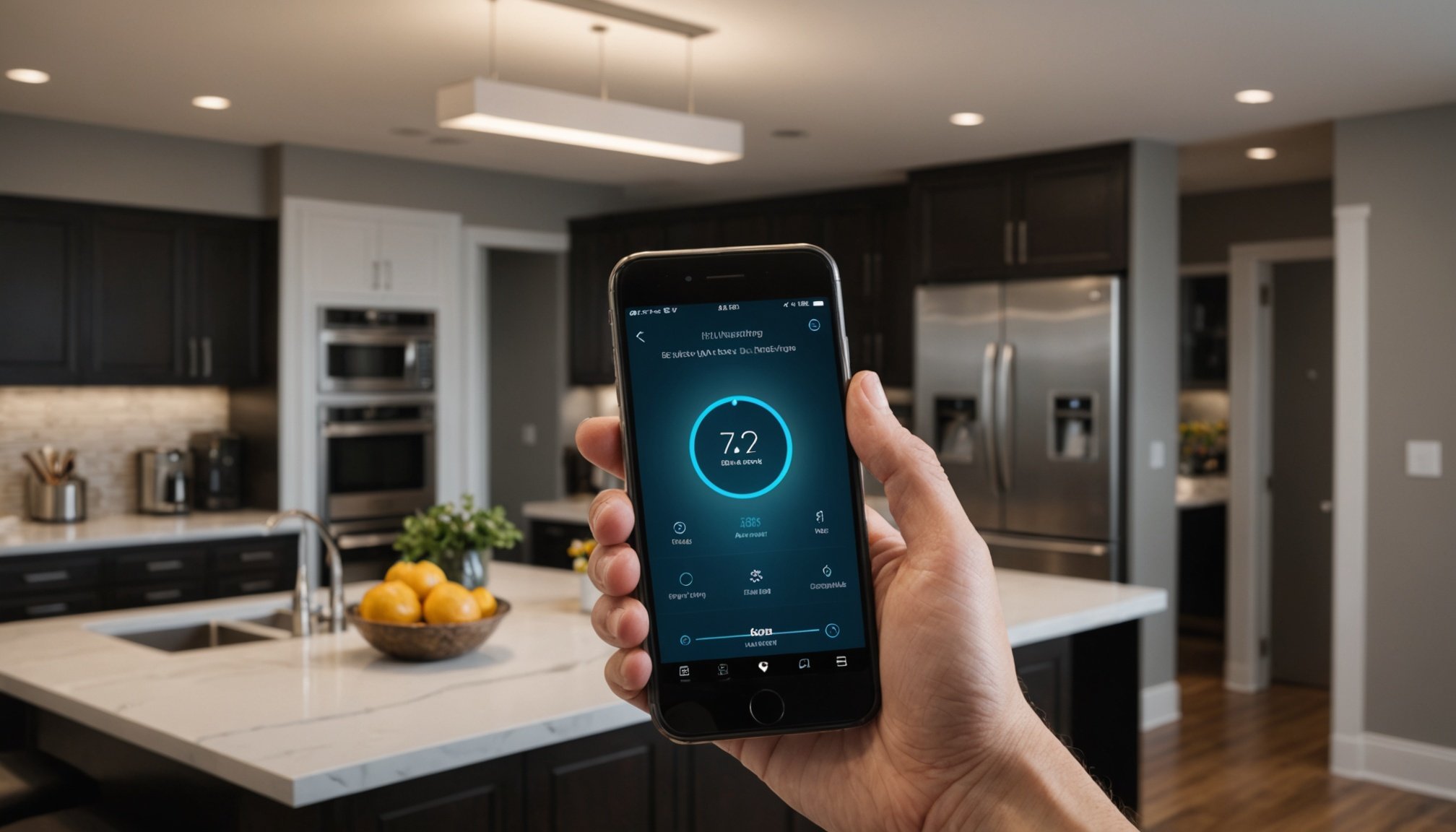Overview of Smart Lighting Technology
Smart lighting technology is redefining the way we illuminate our homes, seamlessly blending with home automation. At its core, this technology enhances energy efficiency by allowing users to control their lighting remotely through mobile control.
Benefits of Smart Lighting
One of the primary benefits of integrating smart lighting with mobile technology is the convenience it offers. With a few taps on your smartphone, you can adjust the brightness, color, and schedule of your lights, even if you’re not at home. This not only improves user experience but also contributes to energy savings, as lights can be programmed to turn off when not in use.
Also to discover : Effortless smartphone connectivity: receive instant notifications from your smart home security cameras
Moreover, smart lighting systems can be integrated with other home automation devices, creating a cohesive and efficient environment. For instance, lights can be set to dim automatically when a movie starts, enhancing the overall ambiance.
Key Features
Smart lighting systems boast an array of features designed to cater to user preferences. These include voice control compatibility with assistants like Alexa or Google Assistant, customizable lighting scenes, and adaptive lighting that adjusts based on time of day or room occupancy. Such innovations are particularly beneficial in enhancing both comfort and security within homes.
In the same genre : Seamlessly set up a smartphone-controlled smart garage door opener: a step-by-step guide
Embracing smart lighting not only streamlines daily routines but also adds a layer of sophistication to modern living spaces.
Popular Smart Lighting Systems
In recent years, smart lighting systems have become increasingly prevalent, offering users a convenient way to enhance their living spaces. This section delves into a review of top-rated smart lighting brands and how they stack up against each other in terms of features and user satisfaction.
Leading the pack is Philips Hue, widely praised for its extensive range of products and seamless integration with various smart home platforms. Users appreciate its versatility and reliability, making it a go-to choice for many. LIFX is another strong contender, offering vibrant color options and exceptional brightness without the need for a hub, adding to its appeal.
When conducting a brand comparison, it’s crucial to consider not just the offerings and costs but also the ease of installation and compatibility with existing systems. For instance, Wyze provides a budget-friendly alternative without skimping on essential features, gaining favor amongst cost-conscious consumers.
User feedback is crucial in determining the real-world effectiveness of these systems. Ratings often highlight key factors such as ease of use, the range of features, and energy efficiency. Product reviews consistently play a significant role in guiding purchasing decisions, ensuring consumers choose products that best suit their needs and preferences.
In conclusion, selecting the ideal smart lighting system involves meticulous consideration of brand reputation, system features, and authentic user experiences.
Mobile Apps for Real-Time Lighting Control
Navigating the world of smart lighting can feel like a daunting task, but smartphone apps make it significantly easier to manage. Among the plethora of apps available, a few have emerged as leaders in the field.
Philips Hue and LIFX are two of the most popular apps, each with a unique user interface and features designed to streamline your lighting control. Philips Hue, for instance, offers an intuitive design that allows users to change the color and intensity of lights with ease, while also offering preset scenes for different moods. Meanwhile, LIFX provides advanced customization options and integration with other smart devices, appealing to tech enthusiasts.
When selecting the right app, it is crucial to consider your specific needs and setup. Compatibility with existing devices is paramount, ensuring seamless operation and preventing future headaches. Consider features such as voice control, which can enhance convenience and accessibility.
User experience often hinges on the intuitive user interface; selecting an app with well-organized menus and clear instructions can greatly enhance the overall satisfaction. Ensuring that your chosen app supports your device’s operating system—be it iOS or Android—will ensure full optimization of your lighting control experience.
Installation Guides for Smart Lighting
Installing a smart lighting system can be a straightforward process if you follow the correct installation guide. Most systems come with detailed step-by-step instructions, designed to make the setup process as simple as possible. Begin by identifying the type of smart lighting suited for your home, such as bulbs, strips, or switches, and refer to the manufacturer’s instructions.
Setup Process
- Step 1: Turn off the power at the circuit breaker to ensure safety.
- Step 2: Install the smart bulbs or light switch as specified by the installation guide.
- Step 3: Download the corresponding app to connect your smart lighting to your home network or system.
- Step 4: Follow in-app instructions to complete the setup process and integrate the smart lighting with your home Wi-Fi.
Overcoming Installation Challenges
Common challenges include compatibility issues with existing fixtures or difficulties in connecting to Wi-Fi. To overcome these, ensure your existing hardware is updated and directly compatible with the smart lighting system. Another tip is to position your router centrally within your home to avoid connectivity issues.
Integration Tips
If you plan to integrate smart lighting with other home technology, ensure all systems are compatible. Use the setup process to sync your lighting with smart home hubs like Alexa or Google Assistant for seamless voice control and automation. Remember, most devices can be grouped and controlled collectively for convenience.
Optimizing Smart Lighting Performance
Smart lighting systems offer numerous advantages, including improved energy efficiency and convenience. The key to maximizing these benefits lies in strategic usage. To optimize lighting, consider these approaches:
1. Energy Efficiency Strategies: Start by using LED bulbs, which are known for their minimal energy consumption yet powerful illumination. Also, take advantage of features like brightness adjustment and colour temperature settings to tailor the lighting to suit your activities while conserving energy.
2. Scheduling and Automation: Automation is crucial for efficiency and convenience. Set schedules to automatically turn on or off lights at specific times, ensuring that lights are only used when needed. Incorporate motion sensors that activate lights only in occupied spaces, reducing unnecessary energy use.
3. User Tips for Maximizing Convenience: Employ voice assistants to control your lighting hands-free. This not only adds convenience but also allows you to manage your lighting system more effectively. For instance, create lighting scenarios that shift based on time or mood, such as dimming lights for a movie night.
Real-life Example: Imagine a household using smart lighting to highlight pathways during nighttime, triggered by motion sensors. This setup ensures safety while being energy-efficient, as lights remain off during inactivity periods.
By implementing these strategies, homeowners can significantly optimize their lighting systems, marrying technology with practicality.
Troubleshooting Common Issues
When facing difficulties with smart lighting systems, it’s crucial to diagnose the common issues accurately. Addressing these can enhance both user experience and efficiency. Frequently, users report connectivity problems, malfunctioning lights, and unresponsive light settings. A systematic approach to troubleshooting can often resolve these problems without the need for professional intervention.
Begin by examining the connectivity. Ensure your lights, bridge, and applications are all connected to a stable Wi-Fi network. Reevaluating network strength and resetting your router might resolve fluctuations. If the lights are unresponsive, check that they are correctly linked to the app and have the latest firmware updates.
For a malfunctioning system, power cycling might be beneficial. Turning the device off and back on resets connections and occasionally fixes bugs. Should these efforts fail, reassessing the compatibility of the bulb with your smart system is prudent.
In cases of persistent problems, it may be necessary to contact customer service for further tech support. When device issues seem beyond personal troubleshooting capabilities, seeking professional help will ensure proper diagnostics and service. Ultimately, timely interventions, either independently or through expert guidance, can prevent prolonged disruptions in your lighting system.
Real-Life User Experiences with Smart Lighting
Exploring user experiences can provide invaluable insights into the practical benefits of smart lighting. Consider the case of Jane, who integrated smart lighting into her home environment. She initially aimed to enhance the ambience, but soon discovered its transformative impact on her daily routine. For instance, the ability to schedule lights not only simplified her mornings but also helped her maintain a more consistent sleep schedule.
Another practical application comes from a family in a bustling city, where smart lighting solutions improved their home security. They reported that automated lights, mimicking their presence when away, significantly reduced their security concerns. Moreover, the case studies illustrate how smart lighting adapts to a variety of needs.
Families with young children particularly appreciate features that allow gentle lighting at night, preventing sleep disruption. On the flip side, for individuals working from home, smart lighting systems offer adjustable brightness levels, which can reduce eye strain during prolonged computer usage.
These diverse user experiences highlight how smart lighting does more than brighten spaces. It supports lifestyles, promotes security and well-being, and even contributes to energy efficiency. It’s not just about illumination; it’s about creating an environment that adapts to and enhances its users’ lives.






